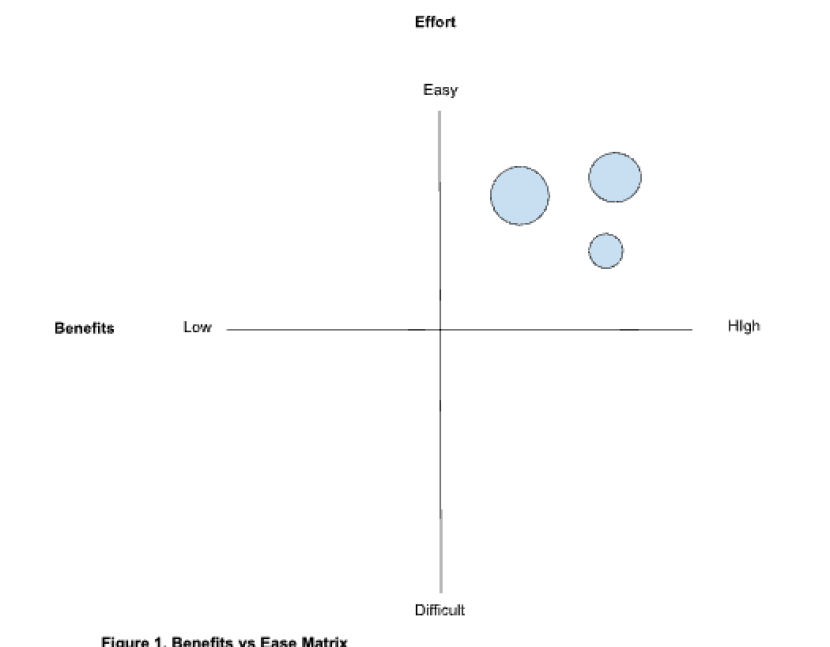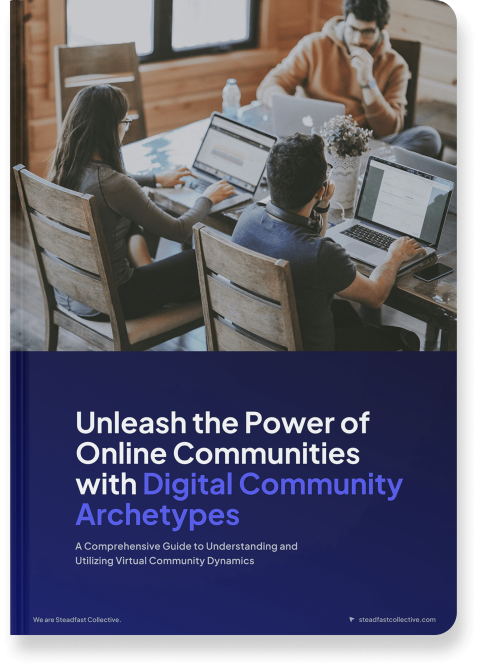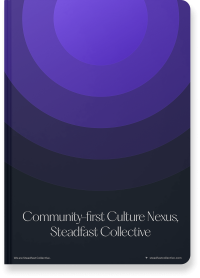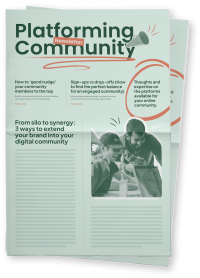Our 2023 Digital Community Leaders Survey Report highlights the many ways online communities benefit businesses and society. From building loyalty, generating ideas for business or social improvement, as well as aiding social connections that improve health outcomes, the value generated outweighs the investment and effort required to sustain them.
Our five step planning process and supporting frameworks help you design, build and evaluate your digital community strategy. Use this method to craft your strategy or assess whether your current approach is fit for purpose.
It complements other customer-centric communications planning tasks including stakeholder mapping, customer segmentation, and journey mapping. This resource, the first in a series, will cover the initial three steps in our process beginning with Digital Community Archetypes.

Five Steps to Community Success
1. Understand digital community archetypes: Observe and understand the purpose and dynamics of diverse online community types.
2. Discover your digital communities: Identify relevant conversations and community spaces for your business or purpose.
3. Align your strategy: Choose communities aligned with your business goals.
4. Activate your digital community ecosystem for impact: Orchestrate your ecosystem to deliver maximum value.
5. Optimise your digital community ecosystem: Continuously refine your approach for efficient goal achievement.
Do we really need a process?
Yes.
Given the vast array of online communities to consider combined with the volume and velocity of online conversations occurring everyday, we created this process to guide you. It helps overcome inefficiencies stemming from fragmented approaches to community engagement while reducing options paralysis.
An organisation may have an active community on LinkedIn or X/Twitter, but then set up a bespoke community without considering relevant stakeholders who are already engaged on the other platforms they may or may not manage. Better results will be achieved when stakeholder needs across multiple platforms are understood and addressed synergistically.

As we transition to web 3.0 innovations including the metaverse and decentralised autonomous organisations (DAOs), individuals will gain greater control and ownership over their data, as well as new opportunities to participate in immersive digital communities.
Keep abreast of web 3.0 development to ensure your digital community strategy keeps pace with stakeholder expectations as technology advances.
Use this process to decide what is right for your organisation. Don’t just follow the herd and rush into new areas just because they are cool. As conversation topics and venues on the web are constantly evolving, periodically repeat this process.
Following this process will sharpen and fine tune your strategy and ensure your community ecosystem delivers maximum value for your members, your business, and society.
How communities drive success
Online communities have been around for decades (Guild, 2020). It is a dynamic landscape where the dominant platforms shift. What remains constant is the human desire for belonging and connection around shared interests that online communities bring, regardless of where they are hosted.
Businesses take heed. Word of mouth is more influential and trusted than advertising (Nielson, 2013, O’Neil 2023). Community sentiment towards your brand impacts your profitability and performance: 82% of adults in the US sometimes read online customer ratings or reviews before purchasing items for the first time, whilst 40% always or almost always doing so (Pew Research Centre, 2016).
Beauty brands have moved promotional budgets into influencer engagement to connect with highly targeted niche communities (Schwarz, 2022). Many retail brands, including both Nike and Adidas, now routinely work with social media influencers to reach younger audiences (Goldstein, 2020).
In the B2B world, professionals increasingly turn to specialist digital communities for learning and development as well as their next career move, hire, or new business lead.
Smart operators pay attention to online communities and the influencers within them to discover insights, ideas, connections and partnerships that will help them succeed.
The most caring organisations understand that the sense of belonging the best communities provide leads to positive health outcomes for members. Social connections help us survive and thrive (House JS, Landis KR, Umberson D., 1988). By investing in community building, brands can deliver transformational value beyond their short term business interests.
Before leaping into action, understand the range of online communities using archetypes that reflect patterns of conversation and behaviour.
Step 1: Understand digital community archetypes
Observe and understand the purpose and dynamics of diverse online community types using ethnographic research.
Ethnography in digital environments, known as netnography, humanises data and helps ensure the nuances of the human experience within online communities are understood (Kozinets, 2019). Netnography helps uncover the tacit knowledge and behaviours which lead to impact at scale. Given these strengths, we’ve developed an ethnographic approach to community building in the form of Community Archetypes. Previous research on community archetypes (Prinster, et al, 2023) validates using archetypes to understand digial communities.
Our Digital Community Archetypes save you time and cognitive energy by producing a quick and easy way to grasp the ethos and praxis of a wide range of virtual communities.
In this context, digital community archetypes are the distinct norms that govern a digital community and convey a sense of belonging to their members.
Here are the Digital Community Archetypes to consider:
Archetype | Focus | Example |
Topica | Shared interests and topics | Threads or fora on Reddit |
Ephemera | Trending conversations | Hashtags and memes e.g. Barbenheimer |
Ludas | Communities for games, sports and hobbies | Minecraft Online Community |
Delectatio | Entertainment fandoms | Potterheads |
Mutua Auxilia | Mutual aid | Mumsnet |
Salus | Health | Patient communities (e.g. MacMillan Online Community) |
Noua | News | Boing Boing’s BBS, Hacker News |
Potus Loculus | Serendipity and water cooler moments | Event fora and meetups, e.g. The Next Web Conference Community |
Communitas Professionalis | Professional development, practice and membership communities providing peer to peer networking and professional development. | Online communities for the British Computing Society, Marketing Society, British Interactive Media Association, Ministry of Testing, etc. |
Communitas Educativa | Education | Alumni groups and interactive media sites for academics and students. Online learning including Coursera. |
Innovatio | Improvement, innovation and crowdfunding | Open London, Kickstarter |
Influentia | Celebrities and influencers | Established and emerging talent on social media platforms including blogs, Youtube, and TikTok. |
Protestati | Campaigning and protest groups | Extinction Rebellion (XR) |
Causa Socialis | Non-profit or charity | Royal Society of the Arts, Commerce and Manufactures online community for Fellows. |
Entitas Servitium | A community primarily providing customer service support for a company | Zendesk slack community. |
Entitas Communio | A brand community primarily focused on engagement. | Harley Davidson Owners Group (HOG) |
Censura | Ratings and reviews of products, services and experiences | Glassdoor, Trust Pilot |
Immersivus | An immersive virtual environment where your aviator or character represents you; you play with others | World of Warcraft (massive multiplayer online role playing game) |
Mercatus | An online marketplace with community features | Ebay, AirBnB |
Organizatio autonoma decentralisata | A decentralised organisation governed by members on blockchain that may focus on any topic. | Longevity DAO |
Table 1: Steadfast Collective Community Archetypes
Online communities may blend different community archetypes or evolve over time. For example, a community may start as a service community but mature to become an engagement community as well.
Familiarise yourself with the Digital Community Archetypes, before moving on to the next step in the planning process.
Think about your own experience in digital communities. What are the most valuable online communities you belong to? What makes them special? What keeps you going back?
Step 2: Discover your digital communities
Once you understand the Digital Community Archetypes, conduct an audit to find the digital communities where relevant conversations about your brand and category are occurring.
Look for evidence of fans but also detractors. How and where do your competitors engage with online communities? If your customers are disgruntled, where do they complain? Are you or your competitors offering support?
Whether it's complimenting or complaining, creating fan art or brand-jacking, discover what gets people talking. It may be helpful to engage in those spaces, but only once you understand the specific digital community dynamics and norms. Sometimes it is more valuable and fitting to listen and learn.
Observing behaviour patterns in digital communities leads to insights which may spark ideas for new campaigns, business improvements, new products or initiatives that will set you apart. Strive to add value based on what you learn, identify where the gaps are, and where you might need to step in or up.
Below is a worksheet to conduct your Digital Community Audit:
Archetype | Example | Nature of conversations and activity | Search terms and sentiment | Norms |
Censura | Glassdoor | Reviews of employee experiences and remuneration. Competitors actively answer comments on their profile. | Neutral to Negative for ‘insert brand name’ | Employers may respond to comments |
Table 2. Digital Community Audit Worksheet
Complete the audit noting conversation themes as well as sentiment. Amend the worksheet for your unique research needs. Include existing groups that include or mention your brand.
A wide range of software tools, including market leading Brandwatch, are available to assist with what in some cases may be a substantial job. (Geyser, W, 2023). Although these tools cannot pick up mentions in private online fora, it will give you a good idea of where the most influential conversations public are occurring and the associated topics and sentiment.
Step 3: Align your strategy
Once you have identified the digital communities relevant for your organisation, begin to assess strategic fit and feasibility against existing resources and capabilities. You can’t be everywhere, so be present where it matters most. Select the online communities, themes and territories that align with your business goals.
Audits provide the foresight needed to anticipate possible challenges as well as spot opportunities. Design your activation strategy to add value, innovate, and make a positive impact.
If your brand targets gamers, like Pringles, it makes great sense to get involved in game related activities that will generate positive sentiment and conversations with your target audience in those communities. (Pringles, 2023)
If you are seeking to attract the best talent, check out your score on Glassdoor based on how employees rate you.
Once you have determined which communities you will focus on, you can begin to craft exactly how content and community engagement will help you achieve your strategy.
Establishing clear goals will ensure you are able to evaluate your impact.
Involve relevant stakeholders internally. Consider what you will do now, next and later. If you have poor employee reviews on Glassdoor, start listening to your employees to find out what is problematic. Don’t stop there. Work internally to fix the problems. Community engagement is not a quick win, it is a long term commitment to become more customer and employee-centric. Set goals and establish strategies to achieve them.
Some organisations put their head in the sand when it comes to community-led challenges, but doing so creates risk. Brands like Nestlé take digital community activity seriously, but only after a crisis (Financial Times, 2010). It doesn’t have to be that way. With foresight, you can proactively engage before a crisis occurs.
At this stage, you may consider whether it is right to host your own community. It is not an easy thing to do. By developing and mastering community engagement on third parties platforms first, you will be better prepared to run your own community.
That said, if demand is evident, the business case is strong, and the necessary resources available, by all means consider it. In some sectors, like membership associations and tech, online communities are increasingly expected.
Use the worksheet below to select the Digital Community Archetypes and sites you will focus on. Consider the relevance of each digital community by giving each a relevance score (High / Medium / Low) based on the fit with your target customers and business strategy.
Archetype | Example | Conversation characteristics and sentiment | Costs and other considerations | Relevance score |
Delectatio | Potterheads | Love to talk about the Harry Potter characters and plots of the film and books | Brand is welcome to share exclusive content for free, e.g. theatre ticket offers | H |
Influentia | Beauty Blogger (up and coming) | Very warm to brand, regularly reviews products | Open to being involved in exclusive brand events for unique content and exposure. | H |
Entitas Communio | Harley Davidson Group | This community delivers great value to existing customers and also attracts new ones. | We also have a cult brand with an active fan base online. We get great engagement with our branded content and have the resources and capability to run our own community. | H |
Table 3. Digital Community Alignment Worksheet
If you have already undertaken a stakeholder mapping exercise, consider where you will be able to influence and reach your priority stakeholders when assessing relevance.
Note whether or not a paid media spend or sponsorship will be required for each option considered.
More detailed work is required to plan influencer engagement. The worksheet helps you get started, but further work to assess fit is required. Once you have gathered all the information you need, plot the most relevant influencers and communities onto a matrix to prioritise them.

Figure 1. Benefits vs Ease Matrix
Select the digital community opportunities with the highest benefits and greatest ease before moving on to more complicated ones.
Once you have decided which communities you will focus on including whether or not you will run your own community, you can begin to plan in detail how you will do it. Use the information gathered to augment and update your customer journey maps.
Questions to ask yourself at this stage
To what extent do you have experience, capability and the resources for regular ‘always on’ publishing / content creation and proactive and reactive community engagement?
Do you have a critical mass of online users who want to engage with each other and representatives of your brand?
What evidence do you have of demand for a bespoke online community?
A tremendous amount of work will go into developing the strategy. We will explore this topic in our next article.
By understanding the community landscape before diving in, you will be better equipped to develop a viable and winning digital community strategy that is aligned with your wider business and marketing plans. Digital Community Archetypes help you understand the range of community options available.
By conducting an audit and rating the relevance of digital communities against your purpose, you will select the right community approach for your business, rather than just following the herd. You will be less likely to waste precious time and resources.
In doing so, you will serve your organisation well, while building your reputation and confidence in your capabilities.
By Ann Longley
References:
Guild, 2020, A timeline of online community types from the 1970s to 2020 ©Guild 2020, Available at: https://guild.co/blog/history-of-online-communities/ (accessed 28 October 2023).
House JS, Landis KR, Umberson D. Social relationships and health. Science. 1988.
Nielsen, 2013, Global Trust in Advertising and Brand Messages, Available at:
https://www.nielsen.com/insights/2013/global-trust-in-advertising-and-brand-messages/ (accessed 28 October 2023)
O’Neil, S, Word of Mouth Marketing: Stats and Trends for 2023, lxahub, 2023 Available at: https://www.lxahub.com/stories/word-of-mouth-marketing-stats-and-trends-for-2023#
(accessed 28 October, 2023)
Pew Research Center 2016, Online Reviews and Ratings, Available at: Online reviews and ratings | Pew Research Center (accessed 28 October 2023).
Schwarz, R, Why social media marketing will only come more popular in the beauty industry, Forbes, 2022,, Available at: https://www.forbes.com/sites/forbescommunicationscouncil/2022/02/15/why-social-media-marketing-will-only-become-more-popular-in-the-beauty-industry-in-2022/ (accessed 28 October 2023)
Goldstein, J, How Social Media Influencers Can Drive Sales For Your Business, Forbes, 2020, Available at: How Social Media Influencers Can Drive Sales For Your Business (forbes.com), (accessed 28 October 2023).
Kozinets, Netnography: Redefined, Sage, London, 2015
Prinster, G, Smith, E, Tan, C, Keegan, B, Community Archetypes: An Empirical Framework for Guiding Research Methodologies to Reflect User Experiences of Sense of Virtual Community, Arvix, 2023, Available at:
https://arxiv.org/pdf/2310.02515.pdf (accessed 28 October 2023)
Geyser, W, Top 25 Social Media Listening Tools for 2024 [Brand Monitoring Tools], Influencer Marketing Hub, 7 November 2023, Available at: https://influencermarketinghub.com/social-media-listening-tools/ (accessed 8 November 2023)
Pringles Gaming, 2023, x.com,, Available at: https://x.com/PringlesGaming/status/1541396804675198979?s=20 (accessed 28 October, 2023)
Ionescu-Somers, A., Enders, A, 2012, How Nestlé dealt with a social media campaign against it , Ft,com, Available at: How Nestlé dealt with a social media campaign against it (ft.com) (accessed 28 October, 2023)


